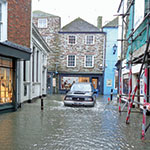 The British Safety Council welcomed the news of the High Court quashing the verdict of the 2014 inquest into the death of nine-year old Ella Kissi-Debrah, who suffered a fatal asthma attack. Her mother Rosamund has since campaigned for a fresh inquest, believing Ella’s death was caused by high levels of air pollution near her home in southeast London. It means that Ella could become the first person in the UK to have air pollution mentioned as a contributory factor on her death certificate.
The British Safety Council welcomed the news of the High Court quashing the verdict of the 2014 inquest into the death of nine-year old Ella Kissi-Debrah, who suffered a fatal asthma attack. Her mother Rosamund has since campaigned for a fresh inquest, believing Ella’s death was caused by high levels of air pollution near her home in southeast London. It means that Ella could become the first person in the UK to have air pollution mentioned as a contributory factor on her death certificate.
Lawrence Waterman, Chairman of the British Safety Council, commented: “The ruling of the High Court is proof that since 2014 we have become much better informed about the dangers of air pollution. Air pollution, linked to as many as 36,000 early deaths a year, is now recognised as the biggest environmental risk to public health. Research from King’s College London suggests that more than 9,400 people die prematurely due to poor air quality in London alone.



 In comparison with many other parts of the world, the UK has a commendable record of protecting the environment from damage and for working constructively with engineers and contractors to mitigate the effects of necessary operations, writes Simon Knott (pictured), managing director of environmental consultancy Naturally Compliant.
In comparison with many other parts of the world, the UK has a commendable record of protecting the environment from damage and for working constructively with engineers and contractors to mitigate the effects of necessary operations, writes Simon Knott (pictured), managing director of environmental consultancy Naturally Compliant. Two environmental charities – Friends of the Earth and the RSPB – and the environmental law firm ClientEarth have started legal proceedings against the Lord Chancellor and Secretary of State for Justice to challenge what they believe to be unlawful new costs rules for environmental cases.
Two environmental charities – Friends of the Earth and the RSPB – and the environmental law firm ClientEarth have started legal proceedings against the Lord Chancellor and Secretary of State for Justice to challenge what they believe to be unlawful new costs rules for environmental cases. Experts from the Institute of Environmental Management and Assessment (IEMA) have expressed concern about the future implementation of European environmental standards following the UK’s secession from the EU, particularly given the uncertainty thrown up by the election result.
Experts from the Institute of Environmental Management and Assessment (IEMA) have expressed concern about the future implementation of European environmental standards following the UK’s secession from the EU, particularly given the uncertainty thrown up by the election result. The Law Society has issued a revised Flood Risk Practice Note to solicitors, reflecting increased concerns over homes and businesses in flood-prone areas. The practice note covers the issues and resources that solicitors need to be aware of when acting for buyers: from Environment Agency flood maps and specialist surveys to insurance.
The Law Society has issued a revised Flood Risk Practice Note to solicitors, reflecting increased concerns over homes and businesses in flood-prone areas. The practice note covers the issues and resources that solicitors need to be aware of when acting for buyers: from Environment Agency flood maps and specialist surveys to insurance.